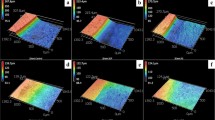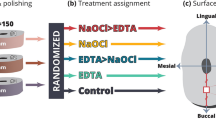Abstract
The treatments for dentin hypersensitivity (DH) may change the surface roughness of the root dentin, which can lead to biofilm accumulation, increasing the risk of root caries. The aim was to compare the surface roughness of root dentin after different treatments of DH and the biofilm formation on those surfaces. After initial surface roughness (Sa) assessment, 50 bovine root fragments received the following treatments (n = 10): G 1—no treatment; G2—5% sodium fluoride varnish; G3—professional application of a desensitizing dentifrice; G4—toothbrushing with a desensitizing dentifrice; and G5—diode laser application (908 nm; 1.5 W, 20 s). The Sa was reevaluated after treatments. Afterward, all samples were incubated in a suspension of Streptococcus mutans at 37 °C for 24 h. The colony-forming units (CFU) were counted using a stereoscope, and the results were expressed in CFU/mL. The one-way ANOVA and the Tukey’s tests compared the roughness data and the results obtained on the bacterial adhesion test (α = 5%). G2 (2.3 ± 1.67%) showed similar Sa variation than G1 (0.25 ± 0.41%) and G5 (5.69 ± 0.99%), but different from group G3 (9.05 ± 2.39%). Group 4 showed the highest Sa variation (30.02 ± 3.83%; p < 0.05). Bacterial adhesion was higher in G4 (2208 ± 211.9), suggesting that bacterial growth is greater on rougher surfaces. The diode laser and the conventional treatments for DH may change the surface roughness of the root dentin, but only brushing with desensitizing dentifrice induced a higher bacteria accumulation on root dentin surface.

Similar content being viewed by others

References
West N, Seong J, Davies M (2014) Dentine hypersensitivity. Monogr Oral Sci 25:108–122
West NX, Seong J, Davies M (2015) Management of dentine hypersensitivity: efficacy of professionally and self-administered agents. J Clin Periodontol 42:S256–S302
Mantzourani M, Sharma D (2013) Dentine sensitivity: past, present and future. J Dent 41:S3–17
West NX, Sanz M, Lussi A, Bartlett D, Bouchard P, Bourgeois D (2013) Prevalence of dentine hypersensitivity and study of associated factors: a European population-based cross-sectional study. J Dent 41:841–851
Bartlett DW, Fares J, Shirodaria S, Chiu K, Ahmad N, Sherriff M (2011) The association of tooth wear, diet and dietary habits in adults aged 18-30 years old. J Dent 39:811–816
Dantas EM, Amorim FK, Nóbrega FJ, Dantas PM, Vasconcelos RG, Queiroz LM (2016) Clinical efficacy of fluoride varnish and low-level laser radiation in treating dentin hypersensitivity. Braz Dent J 27:79–82
Suri I, Singh P, Shakir QJ, Shetty A, Bapat R, Thakur R (2016) A comparative evaluation to assess the efficacy of 5% sodium fluoride varnish and diode laser and their combined application in the treatment of dentin hypersensitivity. J Indian Soc Periodontol 20:307–314
Kapferer I, Pflug C, Kisielewsky I, Giesinger J, Beier US, Dumfahrt H (2013) Instant dentin hypersensitivity relief of a single topical application of an in-office desensitizing paste containing 8% arginine and calcium carbonate: a split-mouth, randomized-controlled study. Acta Odontol Scand 71:994–999
Rosa RR, Calazans FK, Nogueira RD, Lancellotti AC, Gonçalves LS, Geraldo-Martins VR (2016) Effects of different desensitizing treatments on root dentin permeability. Braz Oral Res 30:e111. https://doi.org/10.1590/1807-3107BOR-2016.vol30.0111
Umana M, Heysselaer D, Tielemans M, Compere P, Zeinoun T, Nammour S (2013) Dentinal tubules sealing by means of diode lasers (810 and 980 nm): a preliminary in vitro study. Photomed Laser Surg 31:307–314
Hashim NT, Gasmalla BG, Sabahelkheir AH, Awooda AM (2014) Effect of the clinical application of the diode laser (810 nm) in the treatment of dentine hypersensitivity. BMC Res Notes. https://doi.org/10.1186/1756-0500-7-31
Lee SY, Jung HI, Jung BY, Cho YS, Kwon HK, Kim BI (2015) Desensitizing efficacy of nano-carbonate apatite dentifrice and Er,Cr:YSGG laser: a randomized clinical trial. Photomed Laser Surg 33:9–14
Sgolastra F, Petrucci A, Severino M, Gatto R, Monaco A (2013) Lasers for the treatment of dentin hypersensitivity: a meta-analysis. J Dent Res 92:492–499
Tawakoli PN, Sener B, Attin T (2015) Mechanical effects of different Swiss market-leading dentifrices on dentin. Swiss Dent J 125:1210–1219
Schmidt JC, Zaugg C, Weiger R, Walter C (2013) Brushing without brushing?—a review of the efficacy of powered toothbrushes in noncontact biofilm removal. Clin Oral Investig 17:687–709
Viana PS, Machado AL, Giampaolo ET, Pavarina AC, Vergani CE (2010) Disinfection of bovine enamel by microwave irradiation: effect on the surface microhardness and demineralization/remineralization processes. Caries Res 44:349–357
Geraldo-Martins V, Thome T, Mayer M, Marques M (2013) The use of bur and laser for root caries treatment: a comparative study. Oper Dent 38:290–298
Petersson LG (2013) The role of fluoride in the preventive management of dentin hypersensitivity and root caries. Clin Oral Investig 17:S63–S71
Cummins D (2009) Dentin hypersensitivity: from diagnosis to a breakthrough therapy for everyday sensitivity relief. J Clin Dent 20:1–9
Mello SV, Arvanitidou E, Vandeven M (2013) The development of a new desensitising mouthwash containing arginine, PVM/MA copolymer, pyrophosphates, and sodium fluoride—a hydraulic conductance study. J Dent 41:S20–S25
Klukowska M, Grender JM, Conde E, Goyal CR (2013) A 12-week clinical comparison of an oscillating-rotating power brush versus a marketed sonic brush with self-adjusting technology in reducing plaque and gingivitis. J Clin Dent 24:55–61
Kurtz B, Reise M, Klukowska M, Grender JM, Timm H, Sigusch BW (2016) A randomized clinical trial comparing plaque removal efficacy of an oscillating-rotating power toothbrush to a manual toothbrush by multiple examiners. Int J Dent Hyg 14:278–283
Sorensen JA, Nguyen HK (2002) Evaluation of toothbrush-induced dentin substrate wear using an in vitro ridged-configuration model. Am J Dent 15:26B–32B
Lopes RM, Turbino ML, Zezell DM, Scaramucci T, Aranha AC (2015) The effect of desensitizing dentifrices on dentin wear and tubule occlusion. Am J Dent 28:297–302
de Macedo HS, Colucci V, Messias DC, Rached-Júnior FJ, Fernandes FS, Silva-Sousa YT, Raucci-Neto W (2015) Effect of Nd:YAG (1064-nm) and diode laser (980-nm) EDTA agitation on root dentin ultrastructure properties. Photomed Laser Surg 33:349–356
Bollen CM, Lambrechts P, Quirynen M (1997) Comparison of surface roughness of oral hard materials to the threshold surface roughness for bacterial plaque retention: a review of the literature. Dent Mater 13:258–269
Tada K, Oda H, Inatomi M, Sato S (2014) Characterization and Streptococcus mutans adhesion on air polishing dentin. Odontology 102:284–289
Takahashi N, Nyvad B (2016) Ecological hypothesis of dentin and root caries. Caries Res 50:422–431
Ximénez-Fyvie LA, Haffajee AD, Socransky SS (2000) Comparison of the microbiota of supra- and subgingival plaque in health and periodontitis. J Clin Periodontol 27:648–657
Author information
Authors and Affiliations
Corresponding author
Ethics declarations
Conflict of interest
The authors declare that they have no conflict of interest.
Rights and permissions
About this article
Cite this article
Cury, M.S., Silva, C.B., Nogueira, R.D. et al. Surface roughness and bacterial adhesion on root dentin treated with diode laser and conventional desensitizing agents. Lasers Med Sci 33, 257–262 (2018). https://doi.org/10.1007/s10103-017-2356-x
Received:
Accepted:
Published:
Issue Date:
DOI: https://doi.org/10.1007/s10103-017-2356-x



